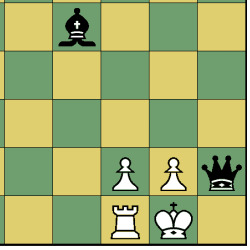Today’s article is about the rules of checkmate.
Checkmate is the object of the game. The object is not to have more pieces than your opponent; it is not to play the most beautiful game; it is to checkmate your opponent’s King.
Checkmate occurs when the King is in check (hopefully your opponent’s King) and he cannot get out of check by any of the possible means.
Here is a typical checkmate pattern.

Notice that the Queen gives check to the King on the diagonal, and the Bishop guards the Queen against capture. Remember from our previous article about check that there are three ways to get out of check: move the King, interpose a piece, or capture the checking piece. Let’s apply those tests to this diagram to see if White can get out of check.
First, the King can has only two hypothetically possible moves: capture the Queen on h2 or move to the vacant square on h1. But both those squares are guarded – h2 by the Bishop and h1 by the Queen. White cannot move out of check.
Second, there is no possible interposition. Whenever the checking piece is in an adjoining square (or when the checking piece is the Knight) interposition is impossible. In those cases only moving the King or capturing the checking piece is a possible means of evading check. In this case the Queen gives check from an immediately adjoining square, so no interposition is possible.
Third, the King could get out of check if a piece (even the King) could capture the checking piece (the Black Queen in this case). But here there is no piece that could capture the Queen other than the King, and the King can’t capture it because the Bishop guards it. The King is not permitted by the rules to move into check.
The King is checkmated.
Have a look at the video to see ways that the King could avoid checkmate using variations on this basic position. And if you want to learn how to checkmate, there are some very good books to teach you just that. Learn Chess: A Complete Course has a chapter entitled “Mating the Castled King” with 45 practice positions for you to learn some of the basics. And if you want to have a lot of positions to practice on, check out 1001 Brilliant Ways to Checkmate, by Fred Reinfeld. (Reinfeld has taught tactics to tens of thousands of chess players through this book. You really need it!)
